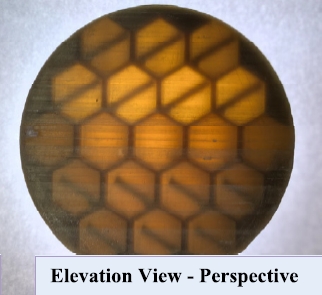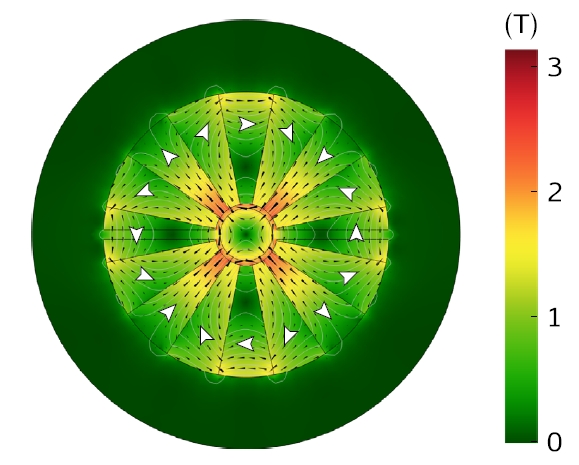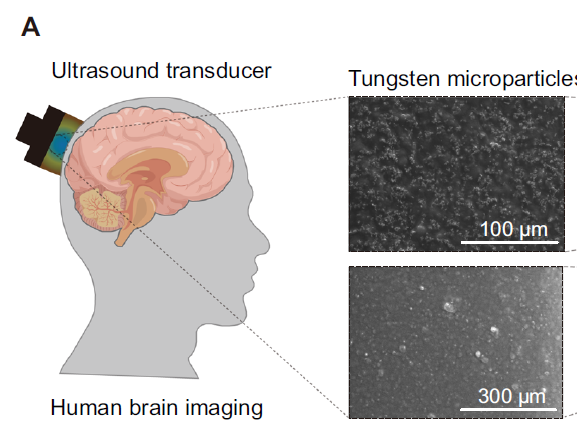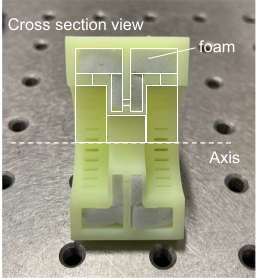Publications
2025
-
 Low-frequency sound absorption enhancement in multi-layer honeycomb metamaterials with embedded long-curved-neck Helmholtz resonatorsZiming Song, Wei Chen*, Shengzhe Jin, Hongwei Zhang, Feihu Shan, and
Low-frequency sound absorption enhancement in multi-layer honeycomb metamaterials with embedded long-curved-neck Helmholtz resonatorsZiming Song, Wei Chen*, Shengzhe Jin, Hongwei Zhang, Feihu Shan, andSichao Qu Applied Acoustics, 2025To overcome the narrow absorption bandwidth of conventional Helmholtz resonator-based acoustic metamaterials in the low-frequency range, this study proposes a multi-layer honeycomb acoustic metamaterial with embedded long-curved-neck Helmholtz resonators (ELCN-HR). A comprehensive methodology integrating theoretical analysis, numerical simulations, and experimental testing is employed to systematically investigate the modulation of resonance frequency by neck geometric parameters and the multi-resonance mode superposition mechanism induced by hierarchical coupling. The results show that the micro-perforation diameter contributes the most in all parameters. Furthermore, the elongated ELCN-HR design substantially reduces resonance frequencies while improving acoustic wave dissipation efficiency. Additionally, the multi-layered coupling architecture excites localized resonance peaks across adjacent frequency bands, facilitating continuous spectral coupling. Optimized simulations demonstrate that the proposed metamaterial achieves a half-absorption bandwidth of 448 Hz (285–733 Hz), representing a 0.32 enhancement compared to conventional single-layer Helmholtz coupled structures (340 Hz). Moreover, the onset frequency for α > 0.5 is reduced from 720 Hz to 285 Hz, significantly extending low-frequency absorption performance. Mechanistic analysis confirms that multi-scale acoustic impedance gradient matching plays a critical role in enhancing broadband energy dissipation. These findings provide a novel design paradigm for developing low-frequency broadband sound-absorbing metamaterials.
-
 Acoustic blackbody through instability-induced softeningMin Yang*,
Acoustic blackbody through instability-induced softeningMin Yang*,Sichao Qu , Nicholas Fang†, and Shuyu ChenCommunications Physics, 2025Perfect wave absorption across all wavelengths is forbidden by the causality principle. Here we demonstrate an approach that circumvents this fundamental limitation in acoustics by coupling unstable components to achieve zero static modulus. Both heuristic model simulations based on different mechanisms (electromagnetic and mechanical) demonstrate the same ultra-broadband absorption exceeding 0.95 at all wavelengths greater than 114 times the absorber thickness, with simultaneous efficient reciprocal radiation capabilities. Theoretical analyses reveal that, counter-intuitively, this strategy approaches ideal blackbody behavior as thickness approaches zero. These findings indicate that fundamental physical constraints no longer prevent blackbody realization, leaving only material limitations as the remaining challenge.
-
 Soft Metalens for Broadband Ultrasonic Focusing through Aberration LayersErqian Dong, Tianye Zhang, Jinhu Zhang, Xiaochun Su,
Soft Metalens for Broadband Ultrasonic Focusing through Aberration LayersErqian Dong, Tianye Zhang, Jinhu Zhang, Xiaochun Su,Sichao Qu , Xin Ye, Zhanyuan Gao, Chengtian Gao, Jiangang Hui, Zhanxiang Wang, and 2 more authorsNature Communications, 2025Aberration layers (AL) often present significant energy transmission barriers in microwave engineering, electromagnetic waves, and medical ultrasound. However, achieving broadband ultrasonic focusing through aberration layers like the human skull using conventional materials such as metals and elastomers has proven challenging. In this study, we introduce an inverse phase encoding method employing tunable soft metalens to penetrate heterogeneous aberration layers. Through the application of effective-medium theory, we determined the refractive index of micro-tungsten particles in silicone elastomer, closely aligning with experimental findings. The soft metalens allows for transmission across broadband frequencies (50 kHz to 0.4 MHz) through 3D-printed human skull models mimicking aberration layers. In ex vivo transcranial ultrasound tests, we observed a 9.3 dB intensity enhancement at the focal point compared to results obtained using an unfocused transducer. By integrating soft materials, metamaterials, and gradient refractive index, the soft metalens presents future opportunities for advancing next-generation soft devices in deep-brain stimulation, non-destructive evaluation, and high-resolution ultrasound imaging.
-
 Generalized causality constraint based on duality symmetry reveals untapped potential of sound absorption
Generalized causality constraint based on duality symmetry reveals untapped potential of sound absorptionSichao Qu , Min Yang*, Sibo Huang, Shuohan Liu, Erqian Dong, Helios Y. Li, Ping Sheng*, I. David Abrahams*, and Nicholas X Fang†Nature Communications, 2025Causality constraints are known to bind sound absorption to a limit that can only be achieved by optimizing the system bandwidth for a specific material thickness. This limit is defined on the assumption of a one-port system, generally causing duality symmetry to be overlooked. Here, we define a general- ized causality constraint of sound absorption by investigating reflection and transmission of a two-port hybrid monopole-dipole resonator. With our the- ory, we show that the absorption limit is approached by relying on the well-established critical coupling as well as by matching effective compressibility and density. We experimentally show that the designed resonator absorbance follows the duality symmetry condition embodied in the large bandwidth reported, confirming an intrinsic connection between duality symmetry and scattering causality. A comparison with a traditional foam liner and other competitive works further validates our findings. Our results reveal previously untapped absorption potential in broadband acoustic metamaterials.
2024
-
 Analytical modeling of acoustic exponential materials and physical mechanism of broadband anti-reflection
Analytical modeling of acoustic exponential materials and physical mechanism of broadband anti-reflectionSichao Qu , Min Yang*, Tenglong Wu, Yunfei Xu, Nicholas X Fang†, and Shuyu ChenMaterials Today Physics, 2024Spatially exponential distributions of material properties are ubiquitous in many natural and engineered systems, from the vertical distribution of the atmosphere to acoustic horns and anti-reflective coatings. These media seamlessly interface different impedances, enhancing wave transmission and reducing internal reflections. This work advances traditional transfer matrix theory by integrating analytical solutions for acoustic exponential materials, which possess exponential density and/or bulk modulus, offering a more accurate predictive tool and revealing the physical mechanism of broadband anti-reflection for sound propagation in such non-uniform materials. Leveraging this method, we designed an acoustic dipole array that effectively mimics exponential mass distribution. Through experiments with precisely engineered micro-perforated plates, we demonstrate an ultra-low reflection rate of about 0.86% across a wide frequency range from 420 Hz to 10,000 Hz. Our modified transfer matrix approach underpins the design of exponential materials, and our layering strategy for stacking acoustic dipoles suggests a pathway to more functional gradient acoustic metamaterials.
2023
-
 Reverberation time control by acoustic metamaterials in a small room
Reverberation time control by acoustic metamaterials in a small roomSichao Qu , Min Yang*, Yunfei Xu, Songwen Xiao, and Nicholas X FangBuilding and Environment, 2023In recent years, metamaterials have gained considerable attention as a promising material technology due to their unique properties and customizable design, distinguishing them from traditional materials. This article delves into the value of acoustic metamaterials in room acoustics, particularly in small room acoustics that poses specific challenges due to their significant cavity resonant nature. Small rooms usually exhibit an inhomogeneous frequency response spectrum, requiring higher wall absorption with specific spectrum to achieve a uniform acoustic environment, i.e., a constant reverberation time over a wide audible frequency band. To tackle this issue, we developed a design that simultaneously incorporates numerous subwavelength acoustic resonators at different frequencies to achieve customized broadband absorption for the walls of a specific example room. The on-site experimental measurements agree well with the numerical predictions, attesting to the robustness of the design and method. The proposed method of reverse-engineering metamaterials by targeting specific acoustic requirements has broad applicability and unique advantages in small confined spaces with high acoustic requirements, such as recording studios, listening rooms, and car cabins.
-
 Omnidirectional broadband phase modulation by total internal reflectionZhida Liu, Jiayao Liu,
Omnidirectional broadband phase modulation by total internal reflectionZhida Liu, Jiayao Liu,Sichao Qu , and Zhaona Wang*Optics Letters, 2023Phase modulation plays a crucial role in shaping optical fields and physical optics. However, traditional phase modulation techniques are highly dependent on angles and wavelengths, limiting their applicability in smart optical systems. Here, we propose a first-principle theory for achieving constant phase modulation independent of incident angle and wavelength. By utilizing a hyperbolic metamaterial and engineering-specific optical parameters, different reflective phase jumps are achieved and tailored for both transverse electric (TE) and transverse magnetic (TM) waves. The aimed reflection phase difference between TE and TM waves can be thus achieved omnidirectionally and achromatically. As an example, we propose a perfect omnidirectional broadband reflection quarter wave plate. This work provides fundamental insights into manipulating optical phases through optical parameter engineering.
2022
-
 Underwater metamaterial absorber with impedance-matched composite
Underwater metamaterial absorber with impedance-matched compositeSichao Qu , Nan Gao, Alain Tinel, Bruno Morvan, Vicente Romero-Garcı́a, Jean-Philippe Groby, and Ping Sheng*Science Advances, 2022By using a structured tungsten-polyurethane composite that is impedance matched to water while simultaneously having a much slower longitudinal sound speed, we have theoretically designed and experimentally realized an underwater acoustic absorber exhibiting high absorption from 4 to 20 kHz, measured in a 5.6 m by 3.6 m water pool with the time-domain approach. The broadband functionality is achieved by optimally engineering the distribution of the Fabry-Perot resonances, based on an integration scheme, to attain impedance matching over a broad frequency range. The average thickness of the integrated absorber, 8.9 mm, is in the deep subwavelength regime ( /42 at 4 kHz) and close to the causal minimum thickness of 8.2 mm that is evaluated from the simulated absorption spectrum. The structured composite represents a new type of acoustic metamaterials that has high acoustic energy density and promises broad underwater applications.
-
 Microwave and acoustic absorption metamaterials
Microwave and acoustic absorption metamaterialsSichao Qu* , and Ping Sheng†Physical Review Applied, 2022Wave absorption metamaterials have been an enduring topic over the past two decades, propelled not only by novel scientific advances, but also by their extensive application potential. In this review, we aim to provide some general insights into the absorption mechanism common to both microwave and acoustic systems. By establishing a universal model for resonance-based metamaterials, we present the theoretical conditions for broadband impedance matching and introduce the fundamental causal limit as an evaluation tool for absorption performance. Under this integrated framework, we survey the recent advances on metamaterials absorption in both microwave and acoustic systems, with the focus on those that pushed the overall performance close to the causal limit. We take note of some new, emerging metastructures that can circumvent the constraint imposed by causal limit, thereby opening a new avenue to low-frequency absorption. This review concludes by discussing the existing challenges with possible solutions and the broad horizon for future developments.
2021
-
 Conceptual-based design of an ultrabroadband microwave metamaterial absorber
Conceptual-based design of an ultrabroadband microwave metamaterial absorberSichao Qu , Yuxiao Hou, and Ping Sheng*Proceedings of the National Academy of Sciences, 2021By introducing metallic ring structural dipole resonances in the microwave regime, we have designed and realized a metamaterial absorber with hierarchical structures that can display an averaged −19.4 dB reflection loss (∼99% absorption) from 3 to 40 GHz. The measured performance is independent of the polarizations of the incident wave at normal incidence, while absorption at oblique incidence remains considerably effective up to 45°. We provide a conceptual basis for our absorber design based on the capacitive-coupled electrical dipole resonances in the lateral plane, coupled to the standing wave along the incident wave direction. To realize broadband impedance matching, resistive dissipation of the metallic ring is optimally tuned by using the approach of dispersion engineering. To further extend the absorption spectrum to an ultrabroadband range, we employ a double-layer self-similar structure in conjunction with the absorption of the diffracted waves at the higher end of the frequency spectrum. The overall thickness of the final sample is 14.2 mm, only 5 % over the theoretical minimum thickness dictated by the causality limit.
-
 Broadband topological valley transport of elastic wave in reconfigurable phononic crystal plateNan Gao,
Broadband topological valley transport of elastic wave in reconfigurable phononic crystal plateNan Gao,Sichao Qu , Liang Si, Jiao Wang*, and Weiqiu Chen†Applied Physics Letters, 2021Topological insulators have attracted intensive attention due to their robust properties of path defect immunity, with diverse applications in electromagnetic, acoustic, and elastic systems. The recent development of elastic topological insulators (ETIs), based on artificially structured phononic crystals, has injected new momentum into the manipulation of elastic waves. Earlier ETIs with unreconfigurable geometry and narrow frequency bandgaps hinder the exploration and design of adaptable devices. In this work, a tunable phononic crystal plate with Y-shaped prisms is designed to support valley transport of elastic waves, based on the analogy of the quantum valley Hall effect. By rotating the prisms to reconstruct the configuration, the mirror symmetry is broken to open a new bandgap. Based on this characteristic, we design an interface between two ETIs with different symmetry-broken geometries, which supports topologically protected edge states. We further design a reconfigurable device for elastic wave channel switching and beam splitting and demonstrate it both numerically and experimentally. In addition, in order to meet the requirement of the wide frequency range, the genetic algorithm is adopted to optimize the geometry so as to achieve the broadband valley transportation of elastic waves. The results obtained in this paper can promote the practical applications of tunable broadband elastic wave transmission
-
 Harnessing post-buckling deformation to tune sound absorption in soft Helmholtz absorbersNan Gao,
Harnessing post-buckling deformation to tune sound absorption in soft Helmholtz absorbersNan Gao,Sichao Qu , Jian Li, Jiao Wang*, and Weiqiu Chen†International Journal of Mechanical Sciences, 2021Helmholtz resonator (HR) has always been an important part of artificial sound-absorbing materials, most of which however cannot be tuned in real time and hence have a limited scope of applications. In this work, we integrate for the first time the soft hyperelastic material into the main structure of HR to design a star-shaped soft Helmholtz absorber. The soft HR exhibits different post-buckling deformation behavior when its wall-thickness varies, which further yields different acoustic characteristics. By combining two star-shaped HRs with different wall-thickness, we are able to achieve asymmetric sound absorption when specific and respective compression loads are applied to the two HRs. In addition, high sound absorption at various frequencies can be obtained via different combinations of the applied loads. Due to the perfect capability of reversible large deformation of soft hyperelastic materials, the sound absorption of the proposed pair of HRs can be real-time tuned effectively by mechanical loading and unloading. In other words, the acoustic switch controlled by mechanical load can be realized. The proposed soft absorber has an obvious practical application value, and also provides an important illustration for the design of soft and tunable acoustic devices.
2020
-
 Minimizing indoor sound energy with tunable metamaterial surfaces
Minimizing indoor sound energy with tunable metamaterial surfacesSichao Qu , and Ping Sheng*Physical Review Applied, 2020The advent of broadband and tunable acoustic metamaterials, amenable to be fabricated into flat panel geometry, offers broad, emerging possibilities for room acoustics. In particular, the fine tuning of surface acoustic impedance becomes possible to optimize specific room acoustic goals. In this initial simulation study we examine the possibility of minimizing the averaged level of energy density (Le), both globally and locally in an enclosed room. The relationship curve between surface impedance and global Le shows an optimal value that can reduce Le by about 15–20 dB over a wide audible frequency regime. Moreover, partial coverage of the room surface by the optimally tuned acoustic metamaterial already demonstrates considerable effectiveness. We compare and verify our numerical model with the statisticaldiffusive acoustics model and find good agreement in the high-frequency regime. In the low-frequency regime, the energy inhomogeneity caused by wave interference can be utilized to create a quiet zone for specific targeted frequency by optimally tuning the surface impedance values at discretized locations on the four walls.